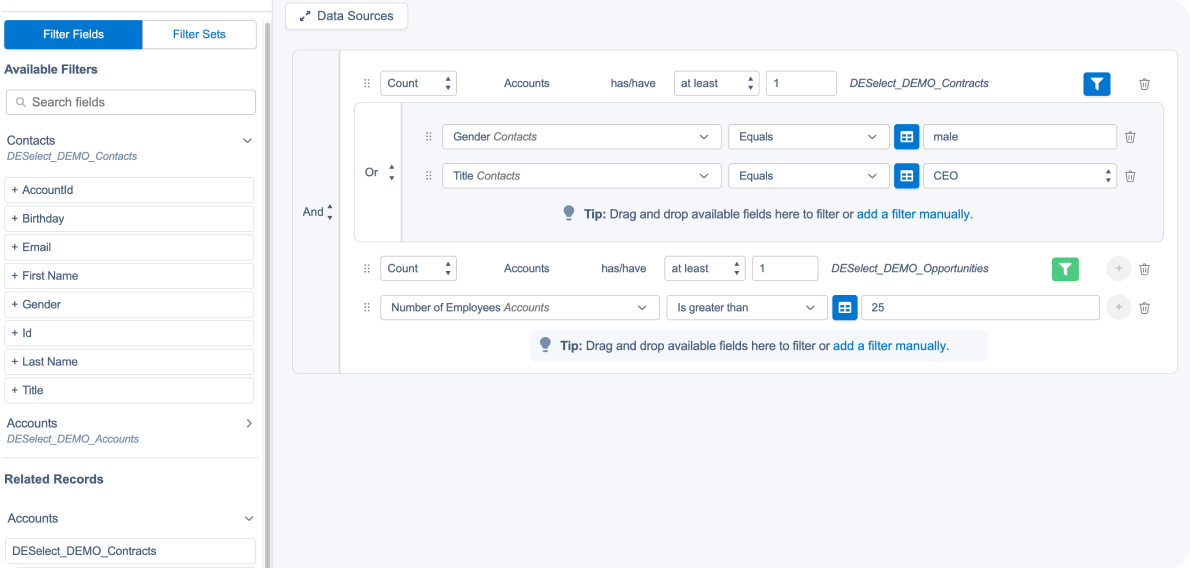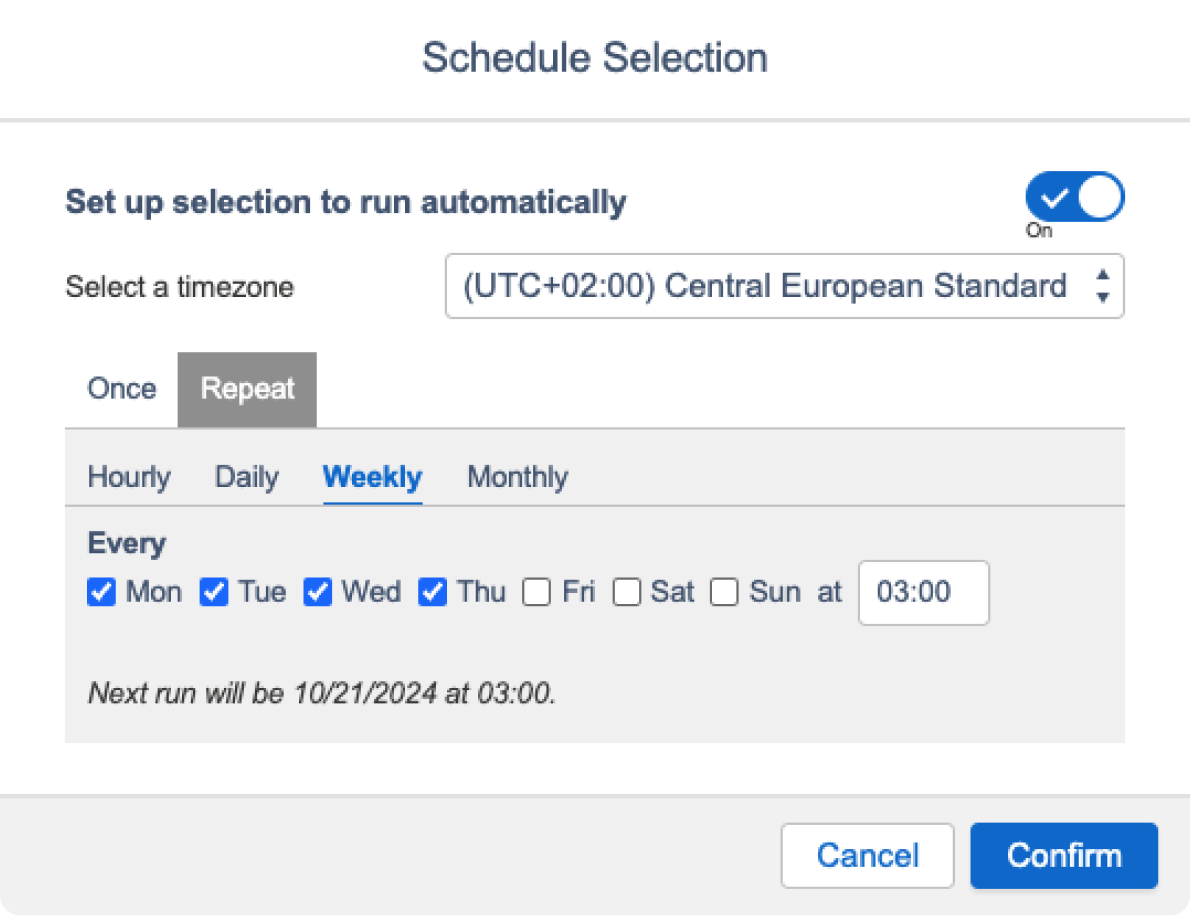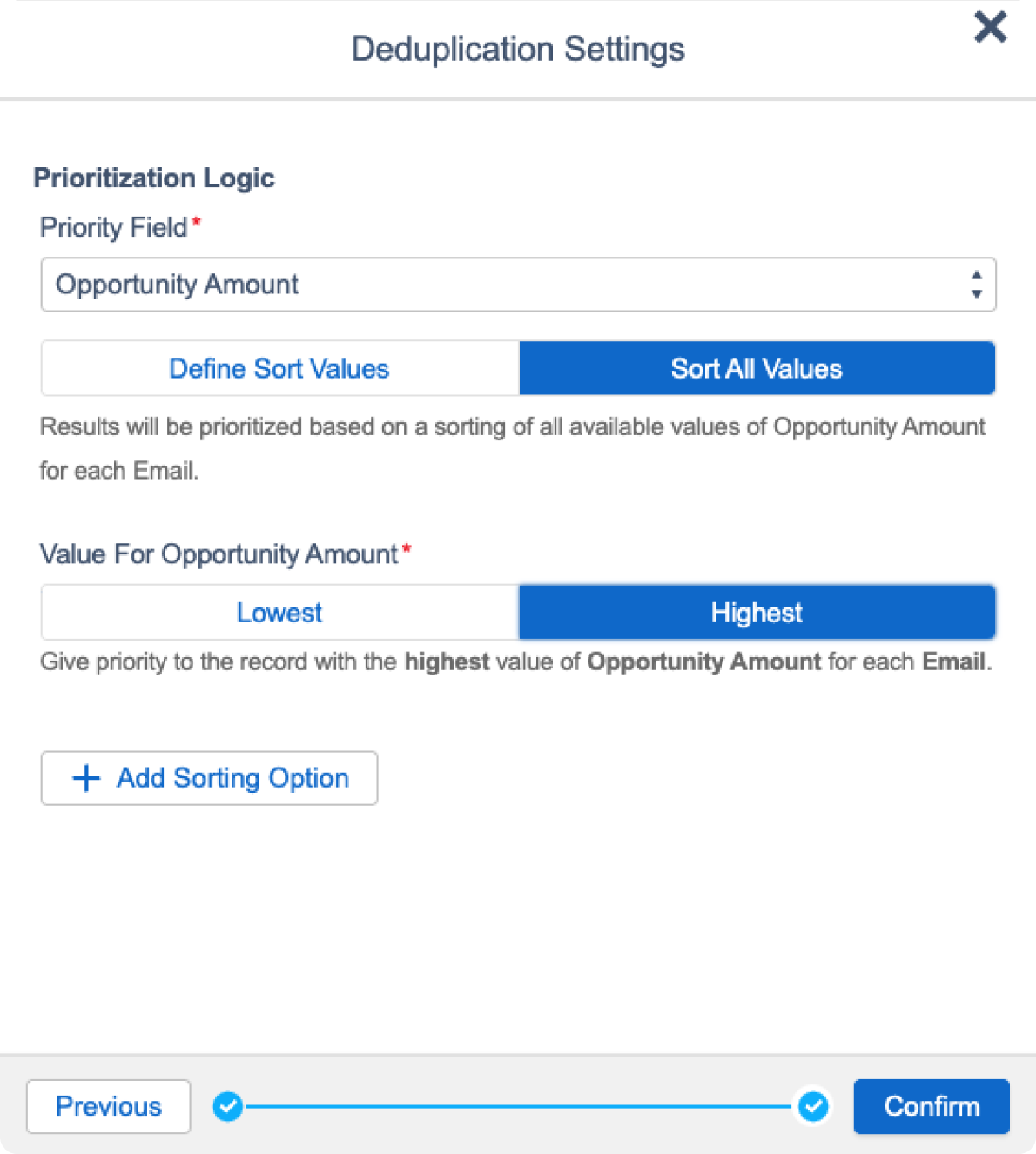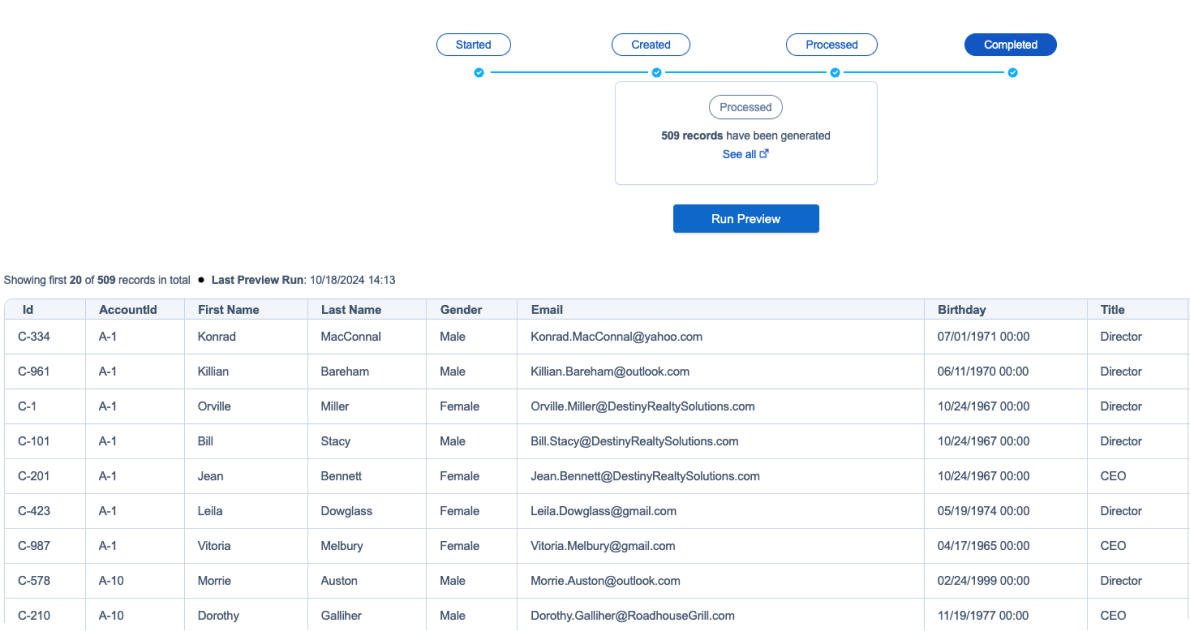SEGMENT
Smart
Segmentation for
Salesforce Marketing Cloud
Easily access all your data extensions in one place, eliminate dependence on technical resources, and create segments 50% faster using drag-and-drop for smart Marketing Cloud segmentation.
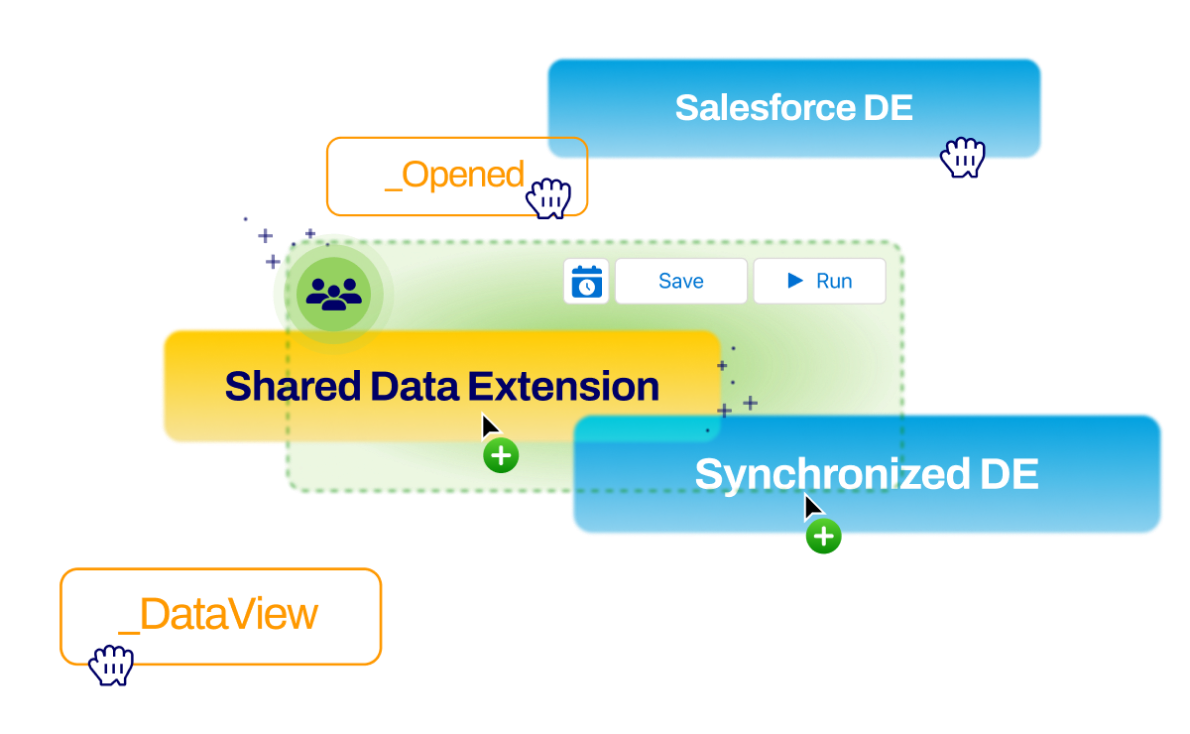
Why Segment
Create highly targeted segments in SFMC in half the time – without SQL.
Build segments twice as fast
Eliminate dependence on IT and inefficient back-and-forth between teams to build segments that reach the right person, with the right message, at the right time
Say Goodbye to SQL
Access all your data extensions, join them together quickly, and predefine relationships – no more wasting time copying queries, switching between studios or checking code for errors.
See how it works
Check out our free, self-paced tutorial to learn how to get started with DESelect Segment quickly and easily.
How it works
-







-
Combine and filter data
extensions with drag-and-drop Combine data extensions simply by dragging one source onto another. Then, apply complex filter criteria and exclusion rules with and/or logic.Get helpful tipsOn-screen guidance helps users navigate to the next step with ease, accelerating the learning curve for new users and making the overall experience easier.
Combine data extensions simply by dragging one source onto another. Then, apply complex filter criteria and exclusion rules with and/or logic.Get helpful tipsOn-screen guidance helps users navigate to the next step with ease, accelerating the learning curve for new users and making the overall experience easier. -
Customize with ease
 Create custom values using advanced calculations, then use them for segmentation, scoring, and personalization. You’re no longer limited to values coming from one of your data sources.
Create custom values using advanced calculations, then use them for segmentation, scoring, and personalization. You’re no longer limited to values coming from one of your data sources. -
Refresh segments automatically
 With scheduled selections you can schedule segments to refresh automatically without using Automation Studio.
With scheduled selections you can schedule segments to refresh automatically without using Automation Studio. -
Eliminate errors with Picklists
 Salesforce Marketing Cloud doesn’t have an out of the box picklist solution when segmenting audiences. With DESelect Picklists choose from a series of values with a drop down, simplifying data entry (saving time) and standardizing values (preventing errors).
Salesforce Marketing Cloud doesn’t have an out of the box picklist solution when segmenting audiences. With DESelect Picklists choose from a series of values with a drop down, simplifying data entry (saving time) and standardizing values (preventing errors). -
Run correlated Selections seamlessly
 Run correlated Selections one after the other, split up large Selections into smaller ones, and run them in a sequence to reduce the risk of time-outs using waterfall segmentation.
Run correlated Selections one after the other, split up large Selections into smaller ones, and run them in a sequence to reduce the risk of time-outs using waterfall segmentation. -
Remove duplicate records
 Set up smart deduplication logic. Prio-deduplication gives you full control over how results are deduplicated, without having to export to Excel or use other magic tricks.
Set up smart deduplication logic. Prio-deduplication gives you full control over how results are deduplicated, without having to export to Excel or use other magic tricks. -
Preview Segments
 DESelect Segment generates efficient, error-free SQL automatically in the background. Preview your segment and associated SQL query directly in the platform.
DESelect Segment generates efficient, error-free SQL automatically in the background. Preview your segment and associated SQL query directly in the platform.
Features
| Key Features | Enable | Plus | Advanced |
| Key Features | Enable | Plus | Advanced |
|
Drag-and-drop i Work with SFMC data using nothing but drag-and-drop. No SQL knowledge is required. |
|||
|
Leverage any Marketing Cloud data i Access shared, Salesforce, synchronized, standard data extensions, and all data views. |
|||
|
Relate as many data extensions or data views as you like i Use drag-and-drop to connect these data extensions or as an admin save relations between two data extensions where each relation contains the two matching columns and the type of the relation. |
|||
|
Apply extensive filtering options, adjusted to any field data format provided by Marketing Cloud i Extract only the data from a data extension or data view that fulfil specified conditions. |
|||
|
Use dynamic date filters, date comparisons, and birthday filters i Easily manipulate date fields to create time-sensitive segments. |
|||
|
Automate your segmentation i Schedule your selections to run at a particular date and time, or create a recurring pattern. |
|||
|
Deduplicate records based on primary keys i Remove duplicate values from a target data extension based on a set of smart rules. |
|||
|
Sort your results based on a logical order and limit your results to the right amount of contacts i Limit the number of results of your selection and sort them based on sorting criteria. Perform A/B tests with this functionality. |
|||
|
Basic prio deduplication i Remove duplicate values from a target data extension based on sorting criteria. |
|||
|
Store calculated values in your target data extension i The results of your calculations are saved in your target definition |
|||
| Team and Admin Features | |||
|
Enjoy increased administrative powers with folder management for selections i Manage your segments using folders and organize your data neatly. |
|||
|
Selection templates i Predefine selections that can serve as a base for new selections. |
|||
|
Build Data Sets and Filter Sets using pre-defined relations (admins) i Data Sets and Filter Sets are reusable predefined sets of data and filters that reduce the time it takes users to make Selections, without the need to deeply understand the data model |
|||
|
Let admins standardize inputs by defining picklists i Simplify data entry and avoid mistakes when setting values. |
|||
|
Copy Selections to other BUs i Duplicate selections in the same or across business units. |
|||
| Advanced Segmentation | |||
|
Append (union) data extensions together to create larger data sets |
|||
|
Perform calculations and segment on aggregated data using subqueries i Check if a field value matches the (filtered) values in a column in another data extension. |
|||
|
Step up personalization with custom values i Create personalized values that source data extensions don’t have. This includes several types like Fixed, Dynamic, Formulas, and Aggregations. |
|||
|
Apply formulas to fields, such as date transformations for time zones i Use it to easily transform your date fields to different time zones, calculate the difference between two dates, or apply different SQL formulas. |
|||
|
Match data extensions that don’t have matching fields or columns i Smoothly connect data extensions with no matching fields by creating a sequential number on each row of data extensions to serve as the matching columns. |
|||
|
Limit the sources you pull information from i Limit the number of records from each source in a selection. |
|||
|
Apply waterfall segmentation to apply multiple steps of cascading rules i Run a series of correlated or unrelated selections one after the other. |
|||
|
Advanced prio deduplication i Remove duplicate values from a target data extension based on a set of smart rules. |
|||
|
Apply any of over 75 supported SQL functions i Create custom values and freely combine as many SQL functions as you need. |
|||
| Expertise and Support | |||
|
Installation i Enjoy our plug-and-play installation process that takes no more than 30 minutes. |
|||
|
Customer Success Manager i Get a dedicated Customer Success Manager that guides you through the installation process. |
|||
|
Support Portal i Visit our Support Portal where you can find FAQs, submit support tickets, learn about different segmentation scenarios, and read about the new functionality. |
|||
| Add-on Services | |||
|
Training |
|||
|
Hypercare |
|||
| *Training and Hypercare are add-on services. Contact sales for more information. | |||
Placeholder title
Marketing segmentation breaks down your audience into smaller, more specific groups, making it easier to deliver targeted messages, drive engagement, and uncover valuable insights. The four primary types of effective marketing segmentation are demographic, geographic, psychographic, and behavioural. Each method helps create more accurate segmentation and align your products or services with the right audience segments.
Demographic Segmentation
Demographic segmentation categorises individuals based on factors such as age, gender, income, education, or occupation. It’s a practical way to match products or services with the needs of specific consumer types. By understanding these basic attributes, marketers can send more targeted messages and gain valuable insights into what drives audience interest and purchasing behavior.
Geographic Segmentation
Geographic segmentation divides your audience by location, such as country, city, region, or even climate. This approach enables the tailoring of products or services to meet local needs and cultural preferences. For accurate segmentation, it’s crucial in global marketing strategy to ensure that your targeted messages resonate within each unique environment or regional market, taking geographic factors into account.
Psychographic Segmentation
This type focuses on lifestyle, interests, attitudes, and values. Psychographic segmentation reveals what motivates your audience beyond just demographics. By tapping into personality traits, marketers can deliver targeted messages that feel more personal. It’s ideal for developing content and offers that align with identity, delivering valuable insights for customer loyalty.
Behavioural Segmentation
Behavioural segmentation is based on actions, like purchase history, product usage, and engagement levels. By analysing customer behavior, brands can build effective marketing segmentation strategies that adapt to real-time needs. It enables accurate segmentation for timely responses, increasing conversions and making each interaction more relevant to specific audience segments.
Pricing
-
Enable
Plan starts at$880 $880 / mo/ per SFMC org (billed annually)- Drag-and-drop segmentation
- Access all your data in Marketing Cloud
- Easily combine multiple data sources
- Create complex audiences without code
- Enable non-technical marketers in SFMC
-
Plus
Plan starts at$1,885 $1,885 / mo/ per SFMC org (billed annually)Every feature from Enable, and:
- Aggregations
- Personalized custom values
- Selection templates
- Pre-define relations with data sets
-
Advanced
Every feature from Plus, and:
- Picklists
- Waterfall segmentation
- Over 75 supported custom SQL functions
| Key Features | Enable | Plus | Advanced |
| Key Features | Enable | Plus | Advanced |
|
Drag-and-drop i Work with SFMC data using nothing but drag-and-drop. No SQL knowledge is required. |
|||
|
Leverage any Marketing Cloud data i Access shared, Salesforce, synchronized, standard data extensions, and all data views. |
|||
|
Relate as many data extensions or data views as you like i Use drag-and-drop to connect these data extensions or as an admin save relations between two data extensions where each relation contains the two matching columns and the type of the relation. |
|||
|
Apply extensive filtering options, adjusted to any field data format provided by Marketing Cloud i Extract only the data from a data extension or data view that fulfil specified conditions. |
|||
|
Use dynamic date filters, date comparisons, and birthday filters i Easily manipulate date fields to create time-sensitive segments. |
|||
|
Automate your segmentation i Schedule your selections to run at a particular date and time, or create a recurring pattern. |
|||
|
Deduplicate records based on primary keys i Remove duplicate values from a target data extension based on a set of smart rules. |
|||
|
Sort your results based on a logical order and limit your results to the right amount of contacts i Limit the number of results of your selection and sort them based on sorting criteria. Perform A/B tests with this functionality. |
|||
|
Basic prio deduplication i Remove duplicate values from a target data extension based on sorting criteria. |
|||
|
Store calculated values in your target data extension i The results of your calculations are saved in your target definition |
|||
| Team and Admin Features | |||
|
Enjoy increased administrative powers with folder management for selections i Manage your segments using folders and organize your data neatly. |
|||
|
Selection templates i Predefine selections that can serve as a base for new selections. |
|||
|
Build Data Sets and Filter Sets using pre-defined relations (admins) i Data Sets and Filter Sets are reusable predefined sets of data and filters that reduce the time it takes users to make Selections, without the need to deeply understand the data model |
|||
|
Let admins standardize inputs by defining picklists i Simplify data entry and avoid mistakes when setting values. |
|||
|
Copy Selections to other BUs i Duplicate selections in the same or across business units. |
|||
| Advanced Segmentation | |||
|
Append (union) data extensions together to create larger data sets |
|||
|
Perform calculations and segment on aggregated data using subqueries i Check if a field value matches the (filtered) values in a column in another data extension. |
|||
|
Step up personalization with custom values i Create personalized values that source data extensions don’t have. This includes several types like Fixed, Dynamic, Formulas, and Aggregations. |
|||
|
Apply formulas to fields, such as date transformations for time zones i Use it to easily transform your date fields to different time zones, calculate the difference between two dates, or apply different SQL formulas. |
|||
|
Match data extensions that don’t have matching fields or columns i Smoothly connect data extensions with no matching fields by creating a sequential number on each row of data extensions to serve as the matching columns. |
|||
|
Limit the sources you pull information from i Limit the number of records from each source in a selection. |
|||
|
Apply waterfall segmentation to apply multiple steps of cascading rules i Run a series of correlated or unrelated selections one after the other. |
|||
|
Advanced prio deduplication i Remove duplicate values from a target data extension based on a set of smart rules. |
|||
|
Apply any of over 75 supported SQL functions i Create custom values and freely combine as many SQL functions as you need. |
|||
| Expertise and Support | |||
|
Installation i Enjoy our plug-and-play installation process that takes no more than 30 minutes. |
|||
|
Customer Success Manager i Get a dedicated Customer Success Manager that guides you through the installation process. |
|||
|
Support Portal i Visit our Support Portal where you can find FAQs, submit support tickets, learn about different segmentation scenarios, and read about the new functionality. |
|||
| Add-on Services | |||
|
Training |
|||
|
Hypercare |
|||
| *Training and Hypercare are add-on services. Contact sales for more information. | |||
-
Free
$0 €0 / mo- Available on Salesforce AppExchange
- Create up to 10 Selections monthly per Business Unit
- Up to two active Business Units
- Each Business Unit may have up to three users and 10 active
- Selections at a given time
-
Enable
Plan starts at$785 €750 / mo/ per SFMC org (billed annually)- Drag-and-drop segmentation
- Access all your data in Marketing Cloud
- Easily combine multiple data sources
- Create complex audiences without code
- Enable non-technical marketers in SFMC
-
Plus
Plan starts at$1,685 €1,600 / mo/ per SFMC org (billed annually)Every feature from Enable, and:
- Aggregations
- Personalized custom values
- Selection templates
- Pre-define relations with data sets
-
Advanced
Every feature from Plus, and:
- Picklists
- Waterfall segmentation
- Over 75 supported custom SQL functions
-
"I can’t envision the marketing department without the use of DESelect. This has really improved our ability to scale as a marketing team because the process of cross training a marketer on our data, the querying process, and how our data interfaces with Salesforce, is so much easier with this tool." Read Story
Trust and Compliance
Security and Data Protection
-
Keep all of your data safe and secure
Keep all your customer data safely in Salesforce Marketing Cloud, as DESelect only stores “metadata” such as data extension names.
-
Fully Compliant with
ISO-27002Rest assured knowing DESelect complies with ISO-27002, covering all aspects of best practice information security policies and processes.
-
Comply with GDPR & CCPA
DESelect complies with both GDPR (General Data Protection Regulation) and CCPA (California Consumer Privacy Act).
-
Securely Connect DESelect
DESelect has passed Salesforce’s security review. Find out more about our secure API connection to Salesforce Marketing Cloud in the DESelect Security Documentation.
Segment Frequently Asked Questions (FAQ)
-
How does Deselect help optimize marketing budgets through segmentation?
Deselect empowers teams to focus their resources on high-value audience segments by enabling quick, precise segmentation, with no coding required. By identifying high-potential groups, marketers can allocate budgets more effectively, reducing waste on low-yield campaigns. This focus improves targeting, boosts customer satisfaction, and ensures better ROI across all marketing efforts. Over time, refined segmentation strategies based on performance data lead to smarter, more cost-efficient decisions. Deselect makes this ongoing optimization process easy and accessible within Salesforce Marketing Cloud.
-
Why is first-party data important for effective segmentation with Deselect?
First-party data, collected directly from customers, is the foundation of meaningful segmentation. Deselect lets marketers harness this data to build precise segments that reflect real customer interests and behaviors. This accuracy helps deliver relevant messages that resonate, particularly to loyal customers who expect personalized experiences.
By regularly reviewing this data in Deselect, teams can stay responsive to emerging trends, adapt the benefits sought, and uncover new engagement opportunities without relying on technical teams or complex SQL queries.
-
Why can't I use Marketing Cloud filters to segment?
Filters are a built-in feature of Marketing Cloud and provide a basic way to segment. However, they offer limited functionality and a suboptimal user experience. For most marketers, filters fall short of their needs.
If you're currently using filters, you'll find that DESelect not only improves ease of use but also allows you to analyze vast amounts of data more efficiently, unlocking far greater segmentation capabilities.
-
Why can't I use Salesforce CRM reports to segment?
‘Salesforce reports’ is a feature of Salesforce CRM (like Service Cloud), which some organizations use to create lists in the CRM and then push this to Marketing Cloud. However, you will need Salesforce CRM and connect it to Marketing Cloud. You will only be able to use the data in the CRM, which typically excludes behavioral data (clicks, opens, etc.) stored in Marketing Cloud in data views. You will pay additional license costs for your marketers who need access to Salesforce CRM to segment, and you will need to train them. This feature is – as the name suggests – actually meant for reporting and has limited segmentation capabilities. You will also miss out on efficiency, as you have to switch back and forth between the CRM and Marketing Cloud. If you currently use Salesforce reports, you will find DESelect offers you much more possibilities and saves you time.
-
What is DESelect Search in SFMC?
DESelect Search is a free Chrome Extension and a free AppExchange app. We created these apps so that you can easily search in your Marketing Cloud to find various objects (data extensions, content, and more) with a click of a button. Based on customer reviews, DESelect Search is a real time saver.
-
Can DESelect scale to my business needs?
We have worked with organizations of different sizes, industries, and geographies, processing over a million records for some of our larger customers. Most of our customers report significant time-saving, shorter campaign cycles, and improved user adoption. Their marketing organizations can operate more independently and can deliver more sophisticated campaigns, yielding better marketing results.
Every company is unique given its organization and data. We encourage you to book a demo to find out precisely how DESelect can benefit you
-
What is segmentation in Salesforce Marketing Cloud?
In Salesforce Marketing Cloud, segmentation involves dividing your audience into meaningful, actionable groups. Think of it as giving your marketing strategy a magnifying glass—letting you zoom in on the right people with the right message.
With tools like Deselect Segment, marketers can build precise segments directly from their segmentation data, without needing to touch a single line of code. Whether you're targeting VIP customers or first-time buyers, smarter Salesforce marketing cloud segmentation helps your team move faster and with purpose. The result? Less guesswork, more impact across your marketing efforts.
-
What is behavioral segmentation in marketing?
Behavioral segmentation zeroes in on what people do, not just who they are. It examines habits, clicks, purchases, and preferences to identify what drives each customer. Rather than lumping audiences into broad buckets, this marketing segmentation approach allows you to tailor messaging based on behavior in real-time. Did someone open three emails but not click on any of them?
That’s a signal. Bought twice last month? Another. These insights power smarter marketing efforts and give your segmentation strategies a dynamic edge. Behavioural segmentation isn’t just data - it’s your audience telling you what they want when they want it.
-
What is an example of behavioral marketing?
Picture this: someone browses your site, and adds a few items to their cart, but doesn’t complete the checkout process. Hours later, they get a personalized email: “Still thinking it over? Here's 10% off.” That’s behavioral segmentation in action - responding to real-time signals with timely nudges. These kinds of triggered, tailored marketing campaigns can dramatically improve engagement and sales.
In the context of marketing cloud tools, it's about turning behavioral clues into smart actions. When done right, behavioral marketing feels less like selling and more like helping, elevating your marketing efforts from generic to genuinely relevant.

